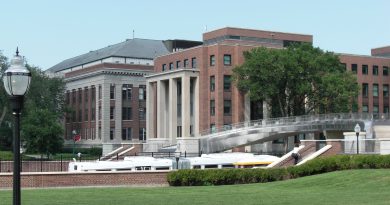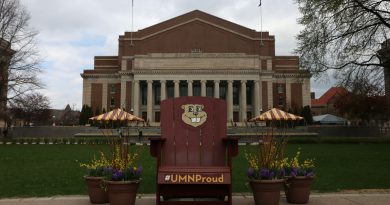Faculty face tough balancing act in the classroom: challenging students in political discussions without silencing them
By Ellen Schneider, Jonah Sprinkel, Katelyn Rademacher and Michael Haubner
Buffalo, Minnesota, isn’t really that far from the Twin Cities—about 40 miles northeast of the University of Minnesota campus.
But for Tara Gravelle, a freshman from Buffalo, the distance is long when she sits in a classroom. She has been surprised by how uncomfortable she gets whenever political topics come up, especially around racism.
“I didn’t realize how open we were gonna be about it,” Gravelle said. And she thinks it’s because of her hometown, which isn’t all that rural but definitely isn’t urban.
Gravelle’s discomfort may be more common for Greater Minnesota students, who were found to be more likely than metro-area students to say they feel uncomfortable talking about politics in classes, according to an AccessU: Beyond the Cities survey in March. Half of the Greater Minnesota respondents said they didn’t feel comfortable speaking about politics in the classroom.
Even so, respondents suggested the faculty seemed to be doing a good job in general at including them in discussions, although they could improve, according to the survey. Of the 184 students who answered the question whether faculty were inclusive of their views in the classroom, nearly 68 percent of students from Greater Minnesota answered “always” or “most of the time.” Slightly over 15 percent said “rarely” or “never.” Of the 41 students who said they had an experience with a faculty member not being inclusive, 16 attributed that experience to students’ rural status.
The results underscore the difficult balancing act faculty must face every time they step into a classroom, particularly one that asks students to consider charged topics of politics or social issues.
Dr. Bill Doherty, a professor of family social science at the university, said the campus should serve as a place of open and educational discourse that incorporates varying beliefs across cultures. The challenge often breaks down when it comes to even moderately conservative students, said Doherty, who has co-founded Better Angels, an organization dedicated to depolarizing the liberal and conservative political parties through group engagement.

“It’s striking how much on the defense reds feel in universities like this,” said Doherty, referring to conservative-leaning students. “And in blue centers, like the Twin Cities, they feel under attack—not just on the basis of their political views, but personally, like they’re racists and homophobic and haters. That’s a lot to live with, not just being wrong in other people’s eyes, but to be a hater.”
Violet Ohnstad, a junior who grew up near Grantsburg, Wisconsin, population 1,317, said she has witnessed a sociology professor declare all white people racist. She has also heard other faculty make jokes about conservatives. Such instances erode her confidence in what the university is teaching, she said.
“I do think then that my education is biased, so then I take it more as a little rock instead of a mountain I should be building my education on,” Ohnstad said, “cause I’m like, ‘Oh, if they don’t include everything, what else are they leaving out?’”
Andrew Jackson, a freshman studying finance, said he talks about politics a lot less when on campus than when he returns to his home in Lester Prairie, Minnesota, population 1,730. He certainly never cracks a political joke.
“I know that, in terms of population, I’m on the losing side and there’s a lot of people that would turn against me,” he said.
Students sometimes do not understand the role faculty play in urging students to challenge their own views, others say. Michal Kobialka, a theatre professor at the university, said he explicitly provokes students to challenge their beliefs and assumptions by exposing them to multiple perspectives—some unsavory and offensive—that will “stretch the formal constructs of traditional American educational practices.”
In one class, he showed the Holocaust documentary “Night and Fog,” which vividly shows up-close shots of bodies in piles and and visceral images, without any trigger warning. Some students left the classroom.
“That’s my function as a teacher—I don’t teach you to confirm what you already know. My function is to perturb what you believe you know, including any system of belief,” Kobialka said.
Jennifer Goodnough, chair of the university’s Senate Committee on Education Policy and a chemistry professor at the Morris campus, echoed Kobialka’s sentiments and reinforced the importance of college being a place that encourages civil, productive discourse.
“Faculty aren’t doing their job if they’re not exposing you to new information and new ideas that might be uncomfortable,” she said. “Where’s the line between challenging you to think about what you believe and making you feel not included?”
Goodnough doesn’t know a single faculty member in the university system that sets up the classroom to be unwelcoming of various viewpoints, even if the professor doesn’t agree with them. She said these tricky situations often prompt the best conversation and learning opportunities, as long as students argue positions based on fact and rhetoric rather than anecdote and emotion.
But, Goodnough admitted, it’s tough to know how much classroom inclusion is actually an issue, and attributed part of its existence to the many complicated, unknown stories of the student body—both rural, urban, and everything in between—on campus.
“Whether it’s rural, first generation, socioeconomic status, religion or another under-represented group, everyone is bringing their story,” Goodnough said. “It’s not written on our foreheads, so people don’t know where you’re coming from right from the start.”
She said these differences can make it exceptionally difficult for students to embrace hard topics.
“It may be interesting to dig into whether issues of inclusion are underpinned with the question of how much you’ve been challenged previously in your life,” she said.
For Goodnough, who grew up in rural Patton, Pennsylvania, this reflection hits close to home. She said her beliefs never challenged until college, and when they finally did, she often got defensive and upset. Being able to understand it’s just a conversation, not an attack, helped bolster her arguments and positions better, she said.
“There’s a growing process to some of this,” she said. “I came out on the other side much more educated.”
Paul Goren, chair of the political science department at the main Twin Cities campus, said he tries to hide his biases in his classes by avoiding negative comments about particular viewpoints.
“But I don’t know how successful I am,” he said. “If the president or a leader makes a racist comment, you have to call that out.”

And despite his reminders to students throughout the semester to engage in “civil discourse,” he said he does notice shifts in the body language of some students when a conservative speaks up in class—eye rolling, smirking and other actions to suggest they likely disagree, he said.
Tim Johnson, another professor in the political science department at the university who teaches constitutional law, liberties and judiciary studies, said he prides himself on being difficult to pinpoint on the ideological spectrum.
“No matter what topic we’re discussing, I’ll play devil’s advocate,” Johnson said. “If a student is pushing one idea or argument, I’m going to push back.”
This method isn’t always popular among students, he said.
“I’ve been accused of being both incredibly liberal and incredibly conservative,” Johnson said, grinning. And he says he wants more professors to take that route.
“It’s not my job to teach you what to think,” he said. “It’s my job to teach you how to think.”
Benjamin Toff, an assistant journalism professor who teaches media politics and public opinion, came to the Twin Cities campus after teaching at the University of Wisconsin, where he said he saw conservative students being much more vocal in class. In Minnesota, it’s a strikingly different climate, both culturally in the state and politically since the 2016 election, he noted.
“I do worry that students feel like they can’t state their views and have a real political discussion because of that political climate,” he said.
Toff is unsure of what the right solution is when combating this issue, or if there’s a solution at all. He said he actively attempts to include all political beliefs in his classroom by bringing in guest speakers from both sides of a particular issue.
The Center of Educational Innovation (CEI), an on-campus organization that collaborates with teachers across the university system to advance effective learning practices, does offer guidelines for promoting an inclusive curriculum designed to support student learning.
According to Ilene Alexander, an education program specialist with CEI, the office doesn’t have clear-cut suggestions or guidelines for teachers when it comes to politically fueled classroom discussions.
When discussing politics, she said the guidelines for professors are, “nuanced by our understanding of demographics, ‘representation,’ and power dynamics in the room.” This means that the educational backgrounds of students influences their ability to learn in the classroom, and should guide teaching styles.
The organization also recommends instructors have students complete reflective writing exercises to “reflect on their own personal views,” and to make sure “they’re putting what they learn in context,” Alexander said.
Further, the university doesn’t have a policy in place that dictates what topics, political or otherwise, can or cannot be discussed in class, including political ones, according to Jennifer Reckner, chief of staff from the Office of Undergraduate Education.
“There are no guidelines that have been developed for all instructors across the university,” Reckner said in an email.
Goodnough is able to provide deeper insight into why a policy could be problematic.
“It’s twofold,” she said. “One would be academic freedom, and the second, First Amendment rights. Those are two things that protect both faculty and students. Any efforts to regulate any of those things could really be chilling and fraught with legal challenges.”
Despite the lack of university policy that points directly to political viewpoints, Goodnough cites a different policy she feels covers the topic indirectly—the Teaching and Learning: Instructor and Unit Responsibilities policy.
The first two sentences of the policy state: Instructors have a responsibility to establish and maintain a civil, productive, inclusive, and stimulating learning environment. Both instructors and students have a fundamental obligation to respect the instructional setting as a place for civil, courteous discourse.
“If you’re going to create an inclusive classroom, you don’t want to set it up so that [students’] viewpoints can’t be shared,” Goodnough said. “It’s OK for them to be different, but they should be able to share [their viewpoints] without fear of repercussion. Policy like that is something we should be pointing to.”
But Graham Sudenga, a senior studying history from Brookings, South Dakota, said updating policy won’t change anything because professors are already doing the best they can. The problem lies elsewhere.
“When professors do present several sides of the issue to be partial, the students that are largely liberal shut down the conservative ideas,” he said. “I think that the divide is perpetuated by students, and that professors only have a certain amount of influence.”
Angel Rose contributed to this story.


